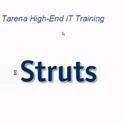The rapid expansion of TAVR to younger, low-risk patients raises concerns regarding device durability. Necessarily, extended stent lifetime will become more critical for new generation devices. In vitro methods commonly used for TAVR stent fatigue testing exclude the effects of the beating heart. We present a more realistic in silico stent fatigue analysis utilizing a beating heart model in which TAVR stents experience complex, nonuniform dynamic loading. Virtual TAVR deployments were simulated in the SIMULIA Living Heart Human Model of a beating heart using stent models of the self-expandable nitinol 26-mm CoreValve and Evolut R devices, and a 27-mm PolyV-2. Stent deformation was monitored over three cardiac cycles, and fatigue resistance was evaluated for the nitinol stents using finite element analysis via ABAQUS/Explicit. In all models, there were elements in which strains exceeded fatigue failure. The PolyV-2 stent had far fewer failing elements since its struts were optimized to reduce the strain in stent joints, achieving better fatigue resistance in the stent crown and waist elements. Different stent sections showed markedly different fatigue resistance due to the varying loading conditions. This study demonstrates the utility of advanced in silico analysis of devices deployed within a beating heart that mimics in vivo loading, offering a cost-effective alternative to human or animal trials and establishing a platform to assess the impact of device design on device durability. The limited fatigue life of TAVR stents indicated here highlights a clinical complication that may eventually develop as younger, lower-risk TAVR patients, age.
翻译:暂无翻译



